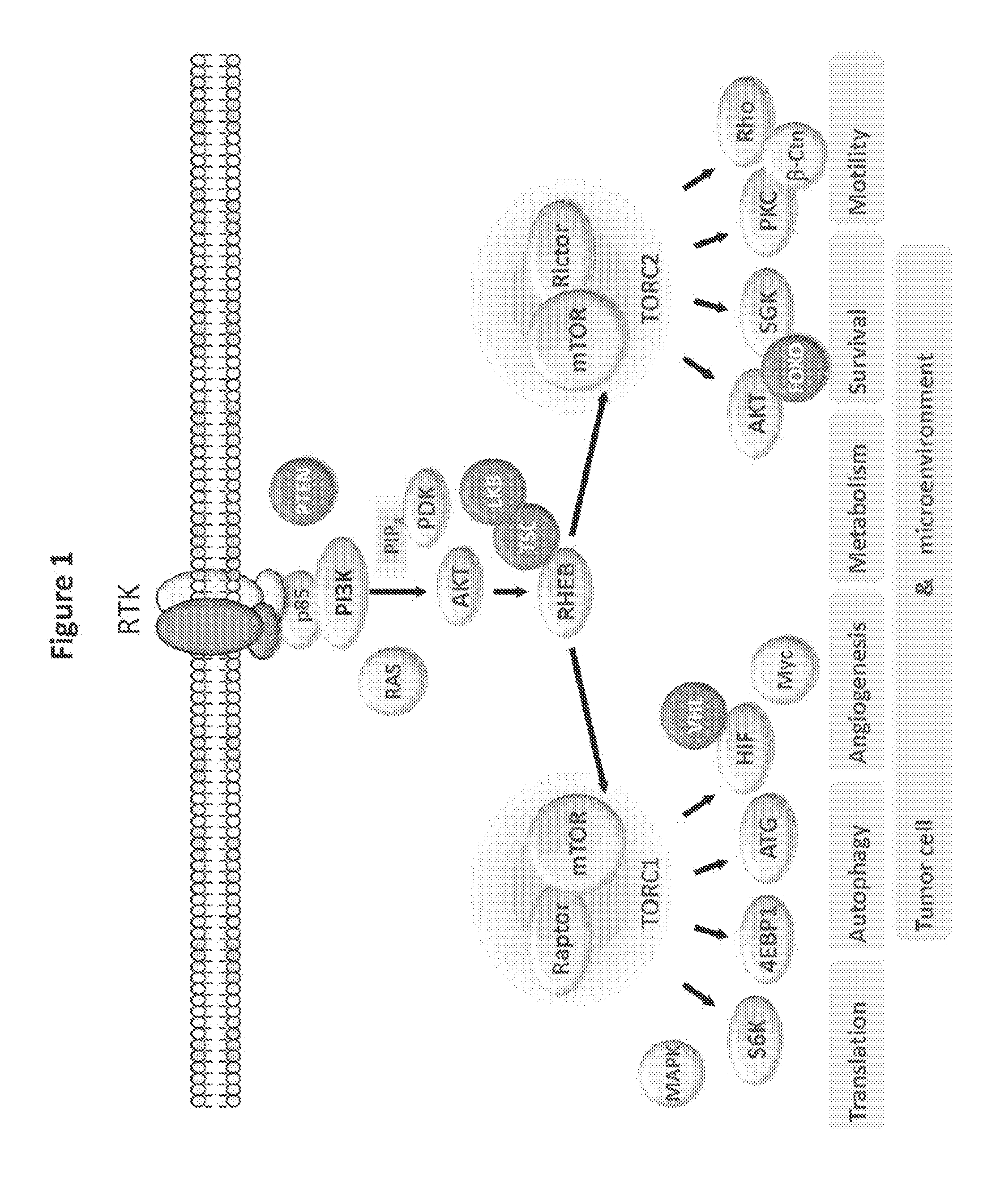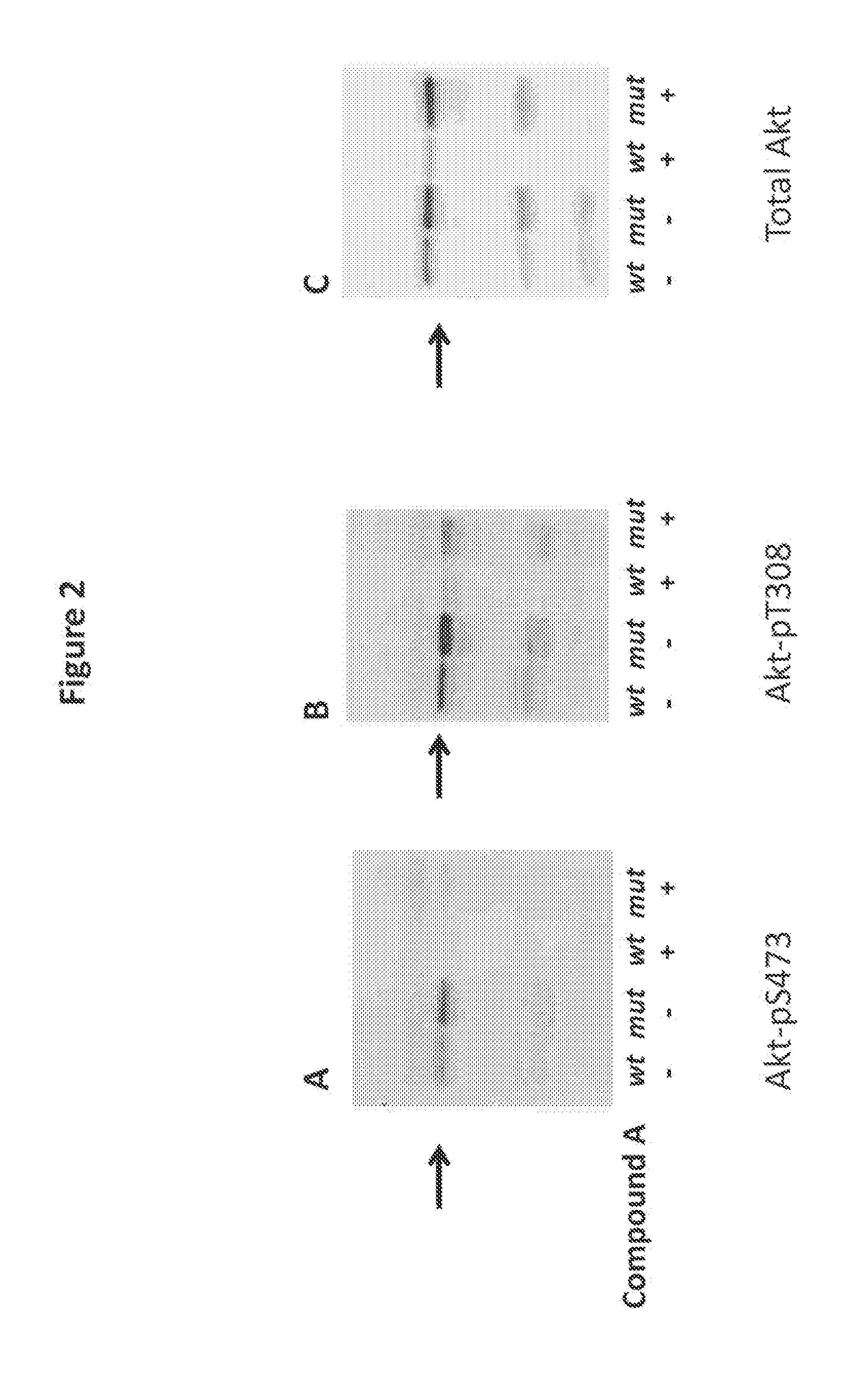Treatment of polycystic disease
a polycystic disease and polycystic disease technology, applied in the field of polycystic disease treatment, can solve the problems of end-stage renal failure, loss of fully differentiated state, increased proliferation, net fluid secretion and the formation of fluid-filled cysts in the kidney, and achieve the effect of reducing cyst formation
- Summary
- Abstract
- Description
- Claims
- Application Information
AI Technical Summary
Benefits of technology
Problems solved by technology
Method used
Image
Examples
embodiment 1
[0307]A method of treating polycystic kidney disease (PKD) in a subject in need thereof, comprising administering to the subject a therapeutically effective amount of a compound of Formula (I):
wherein:
X1 is N or C-E1;
X2 is N or CH;
[0308]E1 is —(W1)j—R4;
W1 is —O—, —NR7A—, —S(O)0-2—, —C(O)—, —C(O)N(R7A)—, —N(R7A)C(O)—, or —N(R7A)C(O)N(R8A)—;
W2 is —O—, —NR7—, —S(O)0-2—, —C(O)—, —C(O)N(R7)—, —N(R7)C(O)—, or —N(R7)C(O)N(R8)—;
[0309]j is 0 or 1;
k is 0 or 1;
R1 is —H, —C1-10alkyl, —C3-8cycloalkyl, —C1-10alkyl-C3-8cycloalkyl, or heterocyclyl, each of which is unsubstituted or is substituted by one or more independent R3;
R2 is hydrogen, halogen, —OH, —R31, —CF3, —OCF3, —OR31, —NR31R32, —NR34R35, —C(O)R31, —CO2R31, —C(═O)NR31R32, —C(═O)NR34R35, —NO2, —CN, —S(O)0-2R31, —SO2NR31R32, —SO2NR34R35, —NR31C(═O)R32, —NR31C(═O)OR32, —NR31C(═O)NR32R33, —NR31S(O)0-2R32, —C(═S)OR31, —C(═O)SR31, —NR31C(═NR32)NR33R32, —NR31C(═NR32)OR33, —NR31C(═NR32)SR33, —OC(═O)OR33, —OC(═O)NR31R32, —OC(═O)SR31, —SC(═O)OR31...
embodiment 2
[0310]A method of treating a polycystic disease in a subject in need thereof, comprising administering to the subject a therapeutically effective amount of a compound of Formula (I):
wherein:
X1 is N or C-E1;
X2 is N or CH;
[0311]E1 is —(W1)j—R4;
W1 is —O—, —NR7A—, —S(O)0-2, CO—, —C(O)N(R7A)—, —N(R7A)C(O)—, —N(R7A)S(O)—, —N(R7A)S(O)2—, —C(O)O—, —CH(R7A)N(C(O)OR8A)—, —CH(R7A)N(C(O)R8A), —CH(R7A)N(SO2R8A)—, —CH(R7A)N(R8A)—, —CH(R7A)C(O)N(R8A)—, —CH(R7A)N(R8A)C(O)—, —CH(R7A)N(R8A)S(O)—, or —CH(R7A)N(R8A)S(O)2—;
W2 is —O—, —NR7—, —S(O)0-2—, —C(O)—, —C(O)N(R7)—, —N(R7)C(O)—, —N(R7)S(O)—, —N(R7)S(O)2—, —C(O)O—, —CH(R7)N(C(O)OR8)—, —CH(R7)N(C(O)R8)—, —CH(R7)N(SO2R8)—, —CH(R7)N(R8)—, —CH(R7)C(O)N(R8)—, —CH(R7)N(R8)C(O)—, —CH(R7)N(R8)S(O)—, or —CH(R7)N(R8)S(O)2— or —N(R7)C(O)N(R8)—;
j is 0 or 1;
k is 0 or 1;
R1 is —H, -aryl, heteroaryl, heterocylcyl, C1-10alkyl, C3-8cycloalkyl, C1-10alkyl-C3-8cycloalkyl, C3-8cycloalkyl-C1-10alkyl, C3-8cycloalkyl-C2-10alkenyl, C3-8cycloalkyl-C2-10alkynyl, C1-10alkyl-C...
embodiment 3
[0312]The method of embodiment 2, wherein said polycystic disease is polycystic kidney disease.
PUM
| Property | Measurement | Unit |
|---|---|---|
| size | aaaaa | aaaaa |
| mass | aaaaa | aaaaa |
| kidney mass | aaaaa | aaaaa |
Abstract
Description
Claims
Application Information
 Login to View More
Login to View More - R&D
- Intellectual Property
- Life Sciences
- Materials
- Tech Scout
- Unparalleled Data Quality
- Higher Quality Content
- 60% Fewer Hallucinations
Browse by: Latest US Patents, China's latest patents, Technical Efficacy Thesaurus, Application Domain, Technology Topic, Popular Technical Reports.
© 2025 PatSnap. All rights reserved.Legal|Privacy policy|Modern Slavery Act Transparency Statement|Sitemap|About US| Contact US: help@patsnap.com



